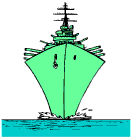The Simulation Ship

![]()
The Simulation Ship

![]()
Goals:
The students will critically analyze different strategies on how to solve their simulation problems.
The students will actively participate in the various discussions.
The students will work effectively with other students in group activities.
Resources:
Materials:
pencils
journals
permission slips
chaperones
transportation to the ship (optional)
Time:
Procedures:
2. The teacher will introduce the speaker to the students.
3. The speaker will explain his/her position to the students.
4. The students will have the opportunity to ask the speaker some of the questions they have prepared for him/her about his/her position and the Navy.
5. After the question and answer session, the speaker will start his/her
presentation about the ship. The presentation's explanations should include
the following:
safety techniques or approaches used in case of an emergency (i.e. drills)
how these safety measures and techniques have changed since the Titanic
communication devices located on the ship (i.e. radar)
use of the communication devices
how these communication devices and their use has changed since the Titanic (i.e. Morse code)
the personnel positions on the ships and their duties
how the personnel positions and their duties have changed since the
Titanic era
7. The speaker will escort the students onto the ship and give them a tour of it. While they are on the ship, the speaker should point out the different parts of his/her presentation.
8. After the tour, have a brief question and answer period about any questions or concerns that the students may have.
9. The teacher will divide the students up into groups of 4-5 people.
10. Each group will be given a simulation problem that centers around
the speaker's presentation. The students will have to decide among themselves
which personnel position they are going to be while figuring out the problem.
Problem #2: You and your crew are headed towards the islands of Japan to refuel before you make your last shipment. There is a distress signal over your radar about 150 miles off your course. The signal states that the ship has been hit by an unknown object and is sinking quickly. It also informs you that there are 2,459 passengers and crew members aboard from Africa. What do you do?
Problem #3: Your passenger ship is headed towards London, England for its next stop. As you are traveling one of your crew members notices that there is a moderate leak in the bow of the ship. If you don't stop the leak, you and your ship could sink. What do you do?
12. Each group will have to write a brief summary on how they solved the problem.
13. After the group is finished with their first problem, the teacher will give them the second one they have to solve.
14. The students will have to decide among themselves which personnel position they are going to be while figuring out the second problem.
15. Each group will collaborate on the problem and will be able to use the ships devices to help them solve it.
16. Each group will have to write a brief summary on how they solved the problem.
17. Each group will present their findings to the whole class, as well as show how they solved their problems step-by-step.
18. The speaker will explain, as well as demonstrate, how the Navy would have solved each of these problems if they happened to occur.
19. A brief question and answer period will be held about the simulation problems.
20. The students will be transported back to school.
21. The students will write about this experience in their journals.
Assessment:
Each group must write up a brief summary on how they solved their simulation problems. Criteria for success: Each summary must include at least four of the possible problems that occurred in their simulation, two different solving strategies, and the final result.
Each team member must actively participate in the various discussions throughout the day. Criteria for success: Each team member must have ample opportunity to speak to the class in at least two or more of the discussions.
Each student will work effectively with the other students in their groups. Criteria for success: Each student must cooperate with one another and respect each other's thoughts and feelings. This assessment will be calculated along with assessment number one on their participation rubric.
Each student must submit an entry in their journals. Criteria for success: Each student must write an entry on how/what they felt about their experience on the ship.
Each team must submit an evaluation on the contribution of every group member. Criteria for success: Each group member must have made a substantial contribution to the team based on the peer evaluation rubric.
The students will receive feedback in the following ways:
They will be given back their summaries of the simulation problems with
a +, +/-, or - depending on the content.
Curricular Strands and Major Points:
Science - solving their simulation problems
Math - solving their simulation problems
Social Studies - critically thinking about how to solve their simulation problem
Have the students present a role play on one of the simulation problems.
Have the students use data from the journals on the ship to calculate certain measurements for the simulation problems.
Have the students locate geographical points through sonar and navigational activities for the simulation exercise.
The Titanic - developed by Kelly Coleman, Nikki Cosgrove, Megan Mills, & Dorothy Weber
This page submitted by St. Norbert College
Ocean Voyagers Program.